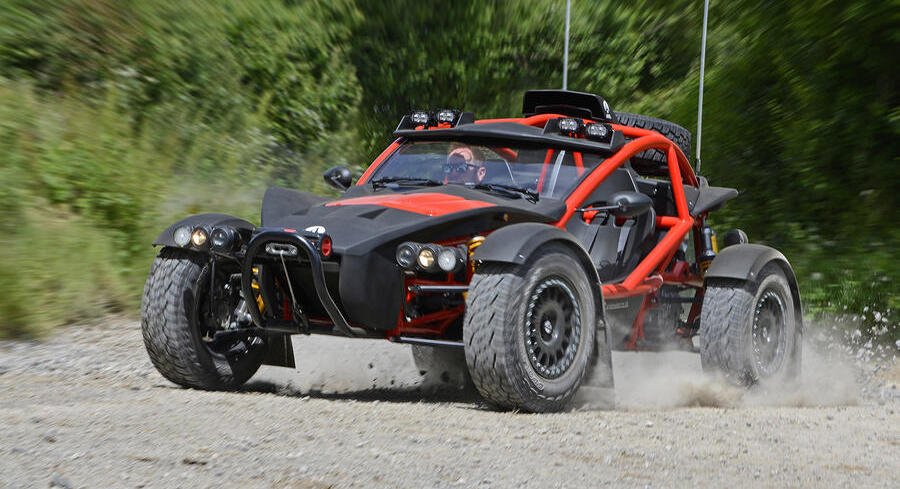Ariel Nomad 2: sub-700kg brawler gets Focus ST power

Ariel has revealed its much-anticipated Nomad 2 performance off-roader ahead of its public debut at the 2024 Goodwood Festival of Speed.
In typical Ariel fashion, the £65,000 newcomer (for which a queue of 80 potential customers had already formed before anyone outside the company had even seen it) is different from its predecessor in almost every mechanical detail except the filler cap and pedal box but remains entirely true to the hugely successful original concept (of which several hundred copies have been sold from Ariel’s tiny Somerset works since 2015).
The Nomad 2’s biggest mechanical change is the adoption of a 2.3-litre four-cylinder turbo petrol engine from Ford, similar in basic spec to that in the current Focus ST but available in three different tunes: 260bhp and 273lb ft of torque, 302 bhp and 330lb ft or 305bhp and 382lb ft, the figures depending on the owner’s choice of power map.
The standard gearbox is the Ford H-pattern six-speed manual that usually accompanies this engine, but Ariel plans to offer a sequential six-speeder as an option.
The company finds the Ford engine easier to source than the Nomad 1’s imported 2.4-litre Honda four, which made 235bhp and 221lb ft (although it has no plans to change the powerful and characterful Civic Type R engine it uses in the Atom 4).
Given the extra power, all variants are likely to be notably faster than the Nomad 1, whose 3.4sec 0-62mph time already made it one of the quickest-accelerating cars on the road.
The Nomad 2 adopts the Atom’s 288mm disc brakes and will also have standard ABS, even though the braking system needs no conventional power booster.
Traction control and stability control are also in the frame, because Ariel has designed the car to qualify for EU Small Series compliance that will free it from the present UK IVA approval process and allow cars to be offered in Europe up to a volume of 1000 per year.
As with the Atom 4, the Nomad 2’s skeletal, transverse mid-engined spaceframe chassis is formed of thicker tubing than its predecessor, with the major side members repositioned to allow better cockpit access.
The new design increases total chassis stiffness by 60%, but even though the Nomad 2 is a shade longer than the original car, its kerb weight rises by only “a few percent”.
Official figures will be issued before the first customer car leaves Crewkerne “this side of Christmas”, but preliminary data puts the new model at 680kg as standard.
The Nomad 2’s all-independent double-wishbone suspension (front and rear) adopts anti-dive and antisquat geometry, which promotes stability despite the fact that it has longer wheel travel.
Chief engineer Jim McKechnie said the Nomad 2 keeps its predecessor’s remarkably soft and absorbent ride on rough roads but can negotiate them even faster.
The cockpit is familiar in layout, with bare-finish composite bucket seats, a small digital instrument pack ahead of the driver and clearly labelled switchgear in blocks nearby on a half-width fascia.
Behind that, the Nomad 2 has high-mounted, self protecting wiring designed to keep it functioning in the toughest of conditions.
So far, prototypes have amassed well over 5000 miles on Welsh rally test tracks, one mile of which is estimated by Ariel engineers to equal 50 miles of road use.
Q&A with Simon Saunders, Director, Ariel
How did the original Nomad come about?
“The germ of the idea started not long after we made the Atom. A guy in America called asking if we could make him an Atom with longer suspension travel. We asked how long he wanted and he said ‘about three feet’. We declined at that stage, but the germ of the idea was there for a car that embodied the idea and principle of the Atom.”
What else is there like it?
“There were various off-road vehicles we looked at, from [Land Rover] Defenders to sandrails to side-by-side buggies to Dakar racers. But there wasn’t anything that embodied a similar principle to the Atom. I guess if you think of an Atom as a race car that’s approachable and usable, there didn’t seem to be a similar vehicle for off-road. They tended to be very, very, extreme vehicles for too-specific a purpose, and didn’t have roadgoing manners.”
What made it an Ariel?
“It’s got to be usable and comfortable on the road and also good fun. We try to make driver’s cars that are good fun; our strapline is ‘serious fun’. And they are serious cars. You [Autocar] set up a challenge between a rally car and a Nomad, and the Nomad won. So it is a serious piece of kit, but at the same time it’s got to be fun, and we put the fun back into driving.”
Related News
